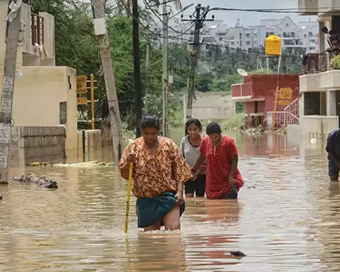Gallery
 PM Modi visit USA
PM Modi visit USA Only the mirror in my washroom and phone gallery see the crazy me : Sara Khan
Only the mirror in my washroom and phone gallery see the crazy me : Sara Khan Karnataka rain fury: Photos of flooded streets, uprooted trees
Karnataka rain fury: Photos of flooded streets, uprooted trees Cannes 2022: Deepika Padukone stuns at the French Riviera in Sabyasachi outfit
Cannes 2022: Deepika Padukone stuns at the French Riviera in Sabyasachi outfit Ranbir Kapoor And Alia Bhatt's Wedding Pics - Sealed With A Kiss
Ranbir Kapoor And Alia Bhatt's Wedding Pics - Sealed With A Kiss Oscars 2022: Every Academy Award Winner
Oscars 2022: Every Academy Award Winner Shane Warne (1969-2022): Australian cricket legend's life in pictures
Shane Warne (1969-2022): Australian cricket legend's life in pictures Photos: What Russia's invasion of Ukraine looks like on the ground
Photos: What Russia's invasion of Ukraine looks like on the ground Lata Mangeshkar (1929-2022): A pictorial tribute to the 'Nightingale of India'
Lata Mangeshkar (1929-2022): A pictorial tribute to the 'Nightingale of India' PM Modi unveils 216-feet tall Statue of Equality in Hyderabad (PHOTOS)
PM Modi unveils 216-feet tall Statue of Equality in Hyderabad (PHOTOS)Hockey India has announced a 54-member core probable squad for the upcoming senior men’s
- Satwik-Chirag return as BAI names 14-strong squad for BWF Sudirman Cup Finals 2025
- Men’s Sr Hockey Nationals to be played in division-based format from April 4
- Mensik denies Djokovic 100th title in Miami final
- KIPG: Son of a vegetable vendor, Bihar’s Jhandu Kumar eyes Worlds, 2028 Paralympics
- Hardik Singh credits hard work and team unity for receiving HI Midfielder of the Year award
Delhi hospital first to remove ruptured cyst without chest surgery Last Updated : 17 Sep 2020 08:03:13 PM IST 
File Photo In a one-of-its-kind medical procedure, the doctors at BLK hospital removed a cyst equivalent to the size of a tennis ball from the right lung of a 45-year-old woman without conducting an open chest surgery.
The patient had developed a ruptured Hydatid cyst in her right lung and suffered from severe difficulty in breathing. However, with the help of a cryoprobe, the doctors successfully excised the ruptured membrane of the cyst.Cryoprobe is a surgical probe used to apply extreme cold to body tissues and freeze them. The membrane was frozen and extracted through the mouth and it gave immediate relief to the patient.Dr Sandeep Nayar, HoD, Chest & Respiratory Diseases, BLK Hospital, who supervised the procedure said surgical removal of the cyst combined with chemotherapy was the most common form of treatment. However, in this case the patient was very reluctant to undergo surgery and wanted immediate relief from her respiratory distress, he added."After a detailed discussion with the CTVS team and family, we decided against surgery. Instead, we froze the ruptured cyst and removed it from the lung through the mouth without opening the chest. The entire procedure took nearly 45 minutes. If we had opted for surgery, we may have experienced complications, especially during these unprecedented times so it was best avoided. This is the world's first such procedure of its kind. The patient got instant relief after the procedure and will be on follow-up deworming medication for the next three months," Dr Nayar informed.Ruhi-Un-Nisa from Srinagar was admitted to the hospital with severe breathlessness and constantly felt a salty-bitter taste in her mouth. The doctors suspected the symptoms were caused by a ruptured Hydatid cyst."She showed initial symptoms and discomfort in July this year when she spit blood while coughing. A CT scan of her chest revealed a cyst with dimensions of 43 X 35 mm in the superior segment of the lower lobe of her right lung. She underwent bronchoscopy procedure thereafter in Srinagar. However, her condition deteriorated and she went into respiratory distress," Dr Nayar said."Nisa was unable to lie down and had not slept for close to two months. She had severe difficulty in breathing, she went to a hospital in Kashmir where she was advised to rush to Delhi for emergency treatment," he added."Her bronchoscopy revealed some whitish membranous structure inside her lung. This was one of a rare case of Hydatid cyst whose removal was a challenge due to its positioning. These membranes are so fragile that they tend to break easily on clasping, Dr Nayar explained.They took up the challenge and a team of doctors led by Nayar started Nisa's treatment."We flushed out the spilled fluids from both of her lungs and excised the ruptured membrane of the cyst. The membrane was frozen with the help of cryoprobe and extracted through her mouth. It was done by bronchoscope while the patient was under local anaesthesia. We repeated the procedure after four days and ensured that the lung was completely cleared of the cyst. The patient is now much better and almost without symptoms," Dr Nayar said."This is the first time that she slept well after more than two months. She slept for 14 hours after the treatment," he added.The Hydatid cysts formed by the larvae of tapeworms are known to trigger an extreme life-threatening allergic reaction in some patients. Humans are accidental hosts of the long tapeworm and become infected by handling soil, dirt or animal hair that contains its eggs.The eggs of the tapeworm contain an embryo which when ingested by a human through eating unclean fruits and vegetables contaminated by dog faeces develops into a Hydatid cyst. This sac-like structure grows to 5 to 10 cm in size within the first year and can survive within the human body for years without showing any significant symptoms. These cysts sometimes become so large that after several years or even decades, they may contain several litres of fluid.The highest occurrence of Hydatid cysts was found in the states of Andhra Pradesh, Tamil Nadu and Jammu and Kashmir. These were caused by the larvae of a long tapeworm (Echinococcus granulosus) found in animals like dogs, sheep, cattle, goats and pigs. The most common sites of occurrence inside human beings were the liver (55-70 per cent) and lungs (18-35 per cent). Unusual sites could be kidneys, heart, spleen, brain, ovaries, (8-10 per cent).IANS New Delhi For Latest Updates Please-
Join us on
Follow us on








172.31.16.186







